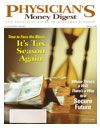Publication
Article
Physician's Money Digest
Carve a Steady Path to Reach Your Goals
Author(s):
In the same vein, the first step toachieve your financial goals isto have an overall strategy. Thesecond step is to know what youcan anticipate as a reasonablelong-term goal for your investments.
Your Primary Goal
Most people define rich as significantlymore than whatever they have. Adesire to be rich just encourages greedand is infinitely more likely to result ina disaster than a successful investment.Being rich should not be your goals; itshould be financial security.
Providing a good living for yourselfand your family and the ability to retireat a reasonable point in your life ratherthan continuing to work for financialreasons only should be your goals.Proper investing and discipline are thetools that will help you reach thesegoals. However, a physician-investorshould have a clear understanding ofwhat to expect during the process.
I will now outline what I believe isa reasonable return vs an exaggeratedreturn. Over the course of the 20thcentury in the United States, stocksreturned on average just under 10%per year. Slightly more than 50% ofthis return was due to capital appreciationand slightly more than 4% wasfrom dividends. But when inflationwas factored out, dividends representedalmost two thirds of the wealth createdby corporations in the 20th century.Dividends are, therefore, animportant component to your investmentstrategy.
It must be emphasized that the 10%gained by stocks is just an average, nota guarantee. In some years gains weregreater or less, and in other years therewere losses. It should be further notedthat periods of over-or underperformancecan last for many years. Forexample, the stock market did notreturn to its 1929 peak until 1954. In1966, the Dow touched 1000. In inflation-adjusted terms, this level was notsurpassed until 1992. There were thustwo periods lasting a quarter of a century(an investing lifetime) of deadmoney. Warren Buffett feels that weare currently in such a period of stockmarket underperformance that couldlast for some time.
Bogus Returns
Whenever a return of 20% per yearor greater is guaranteed or even suggestedby a broker or advisor, thephysician-investor is wise to be skeptical.There are a few true investmentgeniuses such as Buffett, George Soros,and Peter Lynch who can generatesuch returns over a long period of time.The point is that if anyone guaranteesa return on investment significantlymore than 20% and they do not haveevidence, then they are likely to be justplain bogus, with a goal of only separatingyou from your hard-earnedmoney. I suggest the following rule tohelp avoid apparent investments thatare often no more than scams: If youare promised an annual return of 30%or greater, don't invest.
Being a good physician and successfulinvestor require hard work.Physicians spend years training, work60 or more hours a week, and thenspend 15 minutes a month on managingtheir money and their investments.Returns of 10% or greater do not justshow up on your doorstep. I suggestthat you and your spouse devote atleast 1 to 2 hours every week if youexpect to generate an adequate returnon your investments.
graduated from the
University of Chicago, Pritzker School of
Medicine, and completed his medical internship
and residency at the Massachusetts
General Hospital. He retired last year after
23 years of practice with the Missouri Cardiovascular
Specialists in Columbia, Mo. He authored The Physician's
Guide to Investing, A Practical Approach to Building Wealth
(Humana Press; 2005). This book can be purchased at
www.humanapress.com. Many of the themes for this article
are taken from the work of James Turk, who writes for
the Freemarket Gold & Money Report.
Robert M. Doroghazi
